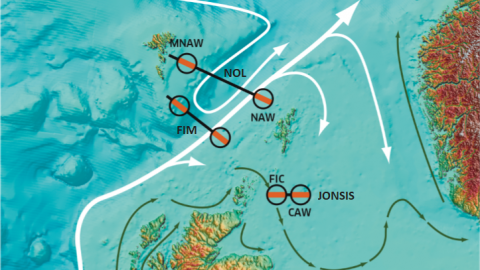Why is it important?
Together with temperature, salinity is an important factor in determining the density of sea water. This has an impact on the movement of ocean currents and also more directly on marine life (such as those floating freely, permanently fixed on the sea floor or migrating), and the regulation of metabolic processes. Salinity variability in Scottish waters is mainly driven by changes in the advection of salt by currents originating in the subpolar North Atlantic Ocean and by freshwater inputs from land (rivers, run-off).
What is already happening?
Salinities in offshore Scottish waters have exhibited strong multi-decadal variability since observations began in the late 19th century. Conditions in the adjacent subpolar North Atlantic Ocean are the main driver of this variability (Hughes et al., 2018).
The salinity of coastal waters is more variable on shorter (year-to-year) time scales due to the influence of fresh water inputs from rivers and land run-off. The west coast of Scotland, due to the high rain fall and year-to-year variability in this, shows greater variability in coastal salinities. Salinities in Scottish waters typically range between 33.1 and 35.2 (see Salinity assessment). The long-term changes in salinity of the coastal and offshore regions around Scotland (Figure 1), are often described as:
- a relatively high salinity period in the early 1970s,
- reduced salinities in the late 1970s and early 1980s,
- increasing relatively higher salinities in the 1980s and 1990s
- a period of sustained high salinity in the 2000s and 2010s.

The discussion of simple linear trends is less meaningful due to this large variability on year-to-year and decadal time scales (Dye, Berx, Opher, Tinker & Renshaw, 2020).
In the last few years, a sharp drop in salinity in the subpolar North Atlantic Ocean was observed. This was due to abnormal wind and circulation patterns in the subpolar gyre region of the North Atlantic Ocean (Holliday et al., 2020).
What is likely to happen in future?
Future climate projections indicate salinities will reduce in Scottish waters by the end of this century (Dye et al., 2020), although considerable uncertainty remains. This freshening is due to changes in the Atlantic Ocean circulation in response to climate change, as well as reduced flow of Atlantic water onto the continental shelf at the shelf edge (Dye et al., 2020; also see Circulation assessment for more information on circulation in general).
Greater salinity decreases are projected for the North Sea than the Irish and Celtic Seas due to the prevailing circulation pathways of water masses with Atlantic Ocean origin. Confidence in these changes is increasing (medium) as multiple studies have reproduced these changes, and understanding of the drivers forcing mechanisms has improved (Dye et al., 2020).
As in the atmosphere and on land, anthropogenic climate change has an impact on the physical environment of the ocean. Public awareness often emphasises warming ocean temperatures, rising sea-levels and ocean acidification, but the impacts extend further. These include changes to the salinity and oxygen concentration of seawater, the currents, waves, storms, coastlines and water column stratification. This section summarises current knowledge of the impacts of climate change that have already been observed and provides an outlook on how conditions are likely to change in future from climate projections.

Links and resources
|
, 2020. Ocean circulation causes the largest freshening event for 120 years in eastern subpolar North Atlantic. Nature Communications , 11. Available at: https://www.nature.com/articles/s41467-020-14474-y. |
|
, 2018. Scottish Ocean Climate Status Report 2016, Marine Scotland Science. Available at: https://data.marine.gov.scot/dataset/scottish-ocean-climate-status-report-2016. |

